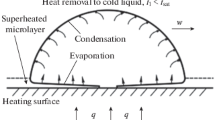Abstract
The depressurization of a high-pressure container in the form of a tube closed at both ends and initially filled with water not heated to the boiling point is studied. At the zero time, one of the ends of the tube is opened, and the liquid begins to escape into the atmosphere. Since the atmospheric pressure is less than the saturation pressure of the liquid, its escape is accompanied by boiling. It is known from experiments [1, 2] that after depressurization a rarefaction wave travels into the channel with the speed of sound in the pure liquid. After it has passed, a two-phase mixture is formed in the container. A “slow” (or “secondary”) rarefaction wave (Fig. 1a) moves through this mixture with a velocity relative to the tube walls of order 10 m/sec, transforming the two-phase mixture to the equilibrium state. To explain the features of the escape process, we propose a new mathematical model of a boiling liquid that takes into account two mechanisms of vapor formation —boiling at nucleating centers present in the liquid and fragmentation of the formed bubbles. If the second mechanism is to be realized, a certain relationship must be established between the bubble size and the difference of the velocities of the phases. The slow rarefaction wave is described by means of the proposed model.
Similar content being viewed by others
Literature cited
A. R. Edwards and T. P. O'Brien, “Studies of phenomena connected with the depressurization of water reactors,” J. Br. Nucl. Energy Soc.,9, 125 (1970).
O. A. Isaev, “Boiling of a liquid in the case of a rapid drop of the pressure in an adiabatic unsteady flow,” Author's Abstract of Candidate's Dissertation [in Russian], Sverdlovsk (1980).
D. A. Labuntsov and A. A. Avdeev, “Theory of a boiling shock,” Teplofiz. Vys. Temp.,19, 552 (1981).
B. I. Nigmatulin and K. I. Soplenkov, “Investigation of unsteady escape of a boiling liquid from channels in a thermodynamically nonequilibrium approximation,” Teplofiz. Vys. Temp.,18, 118 (1980).
A. I. Ivandaev and A. A. Gubaidullin, “Investigation of unsteady escape of boiling liquid in the thermodynamically equilibrium approximation,” Teplofiz. Vys. Temp.,16, 556 (1978).
R. I. Nigmatulin, Dynamics of Multiphase Media, Vol. 1 [in Russian], Nauka, Moscow (1987).
G. K. Batchelor, Introduction to Fluid Dynamics, Cambridge University Press (1967).
D. C. Brabston and H. B. Keller, “Viscous flows past spherical gas bubbles,” J. FLuid Mech.,69, 179 (1975).
L. E. Scriven, “On the dynamics of phase growth,” Chem. Eng. Sci.,10, 1 (1959).
D. A. Labuntsov, B. A. Kol'chugin, V. S. Golovin,et al., “Investigation by means of a fast-motion movie of the growth of bubbles when saturated water boils in a wide range of pressures,” Teplofiz. Vys. Temp.,2, 446 (1964)
G. Birkhoff, Hydrodynamics. A Study in Logic, Fact, and Similitude, Princeton University Press (1960).
Author information
Authors and Affiliations
Additional information
Translated from Izvestiya Akademii Nauk SSSR, Mekhanika Zhidkosti i Gaza, No. 3, pp. 61–66, May–June, 1991.
Rights and permissions
About this article
Cite this article
Ivashnev, O.E., Soplenkov, K.I. The nature of “slow” rarefaction waves accompanying the escape of a boiling liquid. Fluid Dyn 26, 367–372 (1991). https://doi.org/10.1007/BF01059006
Received:
Issue Date:
DOI: https://doi.org/10.1007/BF01059006




